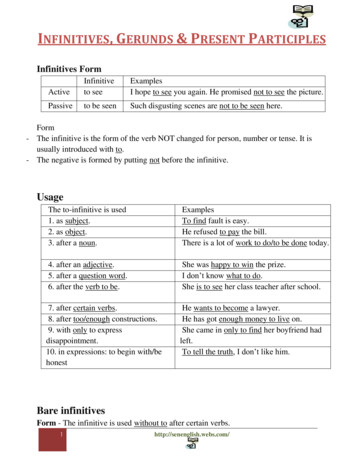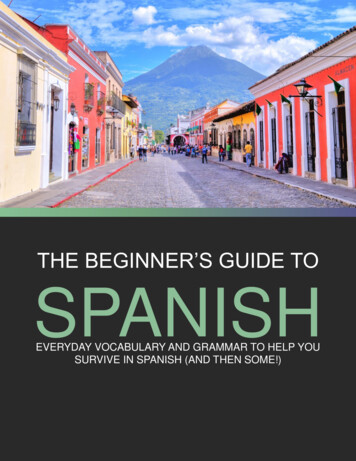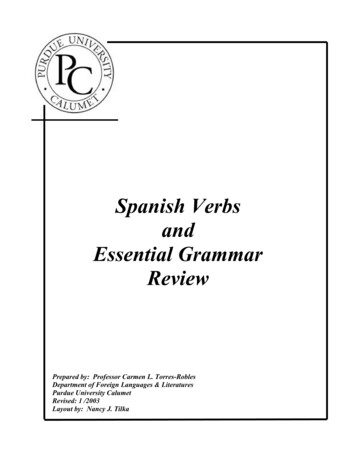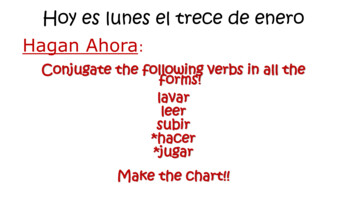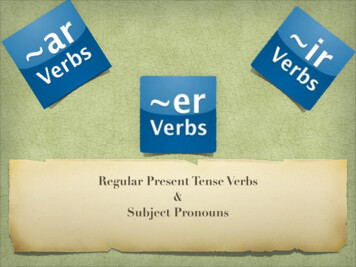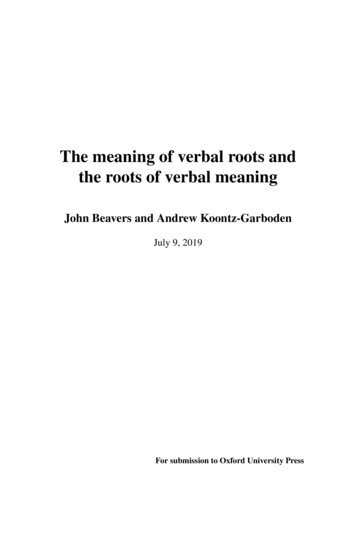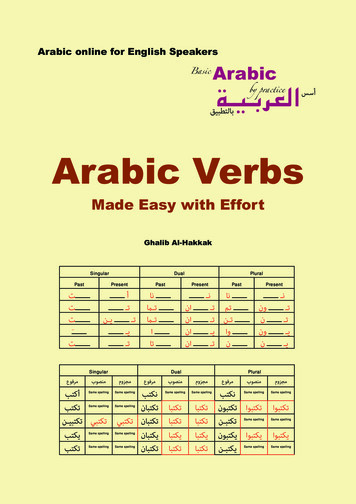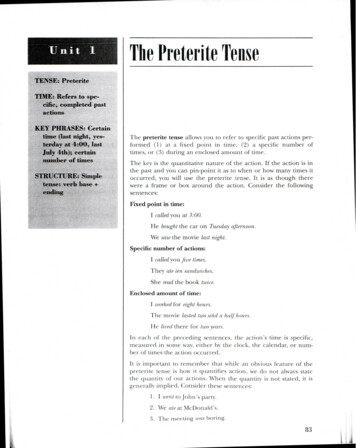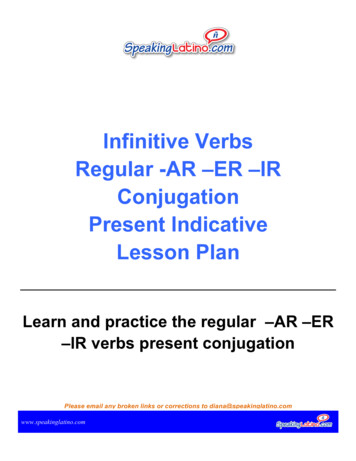
Transcription
Infinitive VerbsRegular -AR –ER –IRConjugationPresent IndicativeLesson PlanLearn and practice the regular –AR –ER–IR verbs present conjugationPlease email any broken links or corrections to diana@speakinglatino.comwww.speakinglatino.com
Learn and practice the –AR –ER –IR verbs present conjugation(English version)Objectives At the end of this activity, students will be familiar with the three Spanish conjugations, and will be able toconjugate regular verbs in present indicative. Also, they will have used them in simple sentences.Activity SummaryStudents will learn verbs’ classification into three categories by trying to classify some verbs on their own.Later, they will watch a video where conjugation of regular verbs in present indicative is explained. Afterpreparing a cheat sheet, they will practice conjugation in a team contest that includes: a. saying to whatconjugation belongs each verb, b. conjugating it in all its persons, and c. after throwing a die, make a simplesentence in the corresponding person with the help of some expressions that are provided.Time allocation30-40 minutesProcedure- Activity 1 - Introduction – Discovering the three conjugationsa. Individually, students will fill in the Handout 1, part 1, trying to infer what the three ‘families’ ofSpanish verbs are from a sample of 6 verbs (two for each conjugation). After finishing part 1, theteacher shows the video Spanish Grammar: Verb Infinitives (https://youtu.be/B3zEPjRdxmA) thatreveals that the infinitive verbs in Spanish end with -AR, -ER o –IR. After that, they use a larger listof verbs (part 2) in order to confirm or reconsider their first guessing.b. When finished, they will get together in pairs in order to compare (and correct if necessary) theanswers (Handout 1, part 1 and 2). Then they will chose from the list the 10 verbs they considermore useful. Each pair explains their list to the entire class. The teacher can write on theblackboard the most ‘popular’ verbs in order to facilitate memorizing.-Activity 2 – Present indicative for the three conjugations (regular verbs) and oral practicea. Students watch the video Las conjugaciones (https://youtu.be/dhY5NNH5VBY) and fill out inHandout 2, part 1.b. In pairs, ask them to analyze the similarities and differences between the endings in all threeconjugations on the Handout 2, part 2. Ask them to create a cheat sheet to easily memorize andremember them (Handout 3). Each group must explain their cheat sheet to the class, and the mostunderstandable will be displayed in the classroom for everyone to see.c. Now, the teacher explains on the board the uses of the present indicative while the students takenotes and write one example on Handout 4.The uses of the present tense:1. To express actions that are happening nowElla escucha música latina.www.speakinglatino.com
Yo preparo la cena.Jorge canta el himno de Estados Unidos.2. To express frequency or ongoing actionsRaúl viaja a San Juan todos los meses.Yo estudio todos los días.Las tiendas abren a las 10am todos los días.3. Characteristics of things that stay the sameLos cubanos hablan español.Mi mamá es puertorriqueña.Todos los bebés lloran.d. The class in divided into two groups. Each group is given a die. There is a deck of verb cards. In thefirst turn, a student from group A takes a verb card from the deck: first, they say to what conjugationgroup the verb belongs (1 point if answer is correct), then they conjugate it in the present (2 points ifall conjugation is correct, 1 point if they make up to two mistakes) and finally they throw the die andmake a simple sentence in the corresponding person (1 yo, 2 tú, etc.) using the elements inHandout 5 (2 points for right sentence). When finished, it’s the other group’s turn, who will repeatthe steps, and so on.Suggested evaluation methodIt is advisable to have a rubric to assess speaking activities in which it should be clear to students how to movefrom one level to the next. A rubric indicating how a student is Meeting, Exceeding or not Meeting Expectationsis the most useful. The suggested “Speaking Production Rubric” can be used (Handout 6).MaterialsVideos:1. Spanish Grammar: Verb Infinitives - https://youtu.be/B3zEPjRdxmA2. Las conjugaciones, «Aprende español con Carmencita» - https://youtu.be/dhY5NNH5VBYHandouts:In the following pages you will find the below list of handouts ready to print:HANDOUT 1: The Three Conjugations in Spanish (pages. 5-6)HANDOUT 2: Regular Verbs in the Present Indicative (pages 7-8)HANDOUT 3: Regular Verbs Cheat Sheet (page. 9 paper size 11” x 17”)HANDOUT 4: The Uses of the Present Tense in Spanish (pages 10-11)HANDOUT 4: Verb Conjugation Contest (pages 12-13)HANDOUT 6: Speaking Production Rubric (page 14)Other:Two dicewww.speakinglatino.com
HANDOUTSwww.speakinglatino.com
Name:The Three Conjugations in SpanishParte 1. Individual work. There are three ’families’ of verbs in Spanish. Discover them by grouping thefollowing verbs in the chart.escribir (to write)meter (to put)-GROUP 1: - Verbstirar (to throw) abrir (to open)beber (to drink)-GROUP 2: - Verbsescuchar (to listen)GROUP 3: - VerbsParte 2. These three groups are called the three conjugations. Here you have some more verbs, with theirmeanings in English. Classify them in the previous chart in order to confirm (or make you reconsider) your firstguess:borrar (to delete) - buscar (to look for) - leer (to read) - hablar (to speak) - completar (to fill out)- comprender (to understand) - subir (to go up) - bajar (to go down) - enseñar (to teach) cantar (to sing) - bailar (to dance) - vivir (to live) - practicar (to practice) - presentar (tointroduce) - esperar (to wait) - perdonar (to forgive) - entrar (to enter) - amar (to love) - vender(to sell) - preparar (to prepare) - responder (to answer) - comprar (to buy) - caminar (to walk) cocinar (to cook) - comer (to eat) - mirar (to watch)Parte 3. In pairs. Compare your answers with your partner. Then discuss: which are the ten most useful verbsfor you? Decide which are the ten verbs you would like to learn first.Our verbs:Verbs in -AR (first conjugation):-Verbs in -ER (second conjugation):-Verbs in -IR (third conjugation):Parte 4. All the class. Which are the ten most useful verbs for the class?The classroom’s verbs:-Verbs in -AR (first conjugation):-Verbs in -ER (second conjugation):-Verbs in -IR (third conjugation):www.speakinglatino.com
Name: ANSWERSThe Three Conjugations in SpanishParte 1. Individual work. There are three ’families’ of verbs in Spanish. Discover them by grouping thefollowing verbs in the chart.escribir (to write)meter (to put)-tirar (to throw) abrir (to open)GROUP 1: - Verbstirar, escuchar, borrar, buscar,hablar, completar, bajar, enseñar,beber (to drink)-escuchar (to listen)GROUP 2: - VerbsGROUP 3: - Verbsmeter, beber, leer, comprender,vender, responder, comerabrir, escribir, vivir, subircantar, bailar, practicar, presentar,esperar, perdonar, entrar, amar,preparar, comprar, caminar,cocinar, mirarParte 2. These three groups are called the three conjugations. Here you have some more verbs, with theirmeanings in English. Classify them in the previous chart in order to confirm (or make you reconsider) your firstguess:borrar (to delete) - buscar (to look for) - leer (to read) - hablar (to speak) - completar (to fill out)- comprender (to understand) - subir (to go up) - bajar (to go down) - enseñar (to teach) cantar (to sing) - bailar (to dance) - vivir (to live) - practicar (to practice) - presentar (tointroduce) - esperar (to wait) - perdonar (to forgive) - entrar (to enter) - amar (to love) - vender(to sell) - preparar (to prepare) - responder (to answer) - comprar (to buy) - caminar (to walk) cocinar (to cook) - comer (to eat) - mirar (to watch)Parte 3. In pairs. Compare your answers with your partner. Then discuss: which are the ten most useful verbsfor you? Decide which are the ten verbs you would like to learn first.Our verbs:Verbs in -AR (first conjugation):-Verbs in -ER (second conjugation):-Verbs in -IR (third conjugation):Parte 4. All the class. Which are the ten most useful verbs for the class?The classroom’s verbs:-Verbs in -AR (first conjugation):-Verbs in -ER (second conjugation):-Verbs in -IR (third conjugation):www.speakinglatino.com
Name:Regular Verbs In Present IndicativeParte 1. Individual work. Watch the video Las conjugaciones https://youtu.be/dhY5NNH5VBY) and fill out thechart with the conjugations of regular verbs in present. Then compare with your úestudibebvivél, ella, ustedestudibebvivnosotros, nosotrasestudibebvivvosotros, vosotras*estudibebvivellos, ellas, ustedesestudibebviv*Remember! Vosotros, vosotras is used in Spain to refer to friends or members of your family. It is informal(similar to ‘you guys’). In formal situations ustedes is preferred. In Latin America only ustedes is used.Parte 2. Are there elements in common in the endings of all three conjugations? Discuss it with your partnerand prepare a cheat sheet to easily memorize how to conjugate regular verbs.Notes:www.speakinglatino.com
Name: ANSWERSRegular Verbs In Present IndicativeParte 1. Individual work. Watch the video Las conjugaciones https://youtu.be/dhY5NNH5VBY) and fill out thechart with the conjugations of regular verbs in present. Then compare with your partner.yotúél, ella, ustednosotros, nosotrasvosotros, vosotras*ellos, ellas, member! Vosotros, vosotras is used in Spain to refer to friends or members of your family. It is informal (similar to‘you guys’). In formal situations ustedes is preferred. In Latin America only ustedes is used.Parte 2. Are there elements in common in the endings of all three conjugations? Discuss it with your partnerand prepare a cheat sheet to easily memorize how to conjugate regular verbs.Notes:www.speakinglatino.com
Conjugation of Regular Verbs in SpanishCheat SheetCreatedbyGroup:
Tres usos del presente indicativoThree Uses of Present Tense in Spanish1"2"EL PRESENTE INDICATIVOThe uses of the present tensewww.speakinglatino.com3"
Tres usos del presente indicativoThree Uses of Present Tense in Spanish1"To#express#ac o#express#frequency#or#ongoing#ac ons#Yo#estudio#todos#los#días.#3"Characteris cs#of#things#that#stay#the#same#EL PRESENTE #español.#
Regular Verbs Conjugation ContestNow the class will be divided into two groups. A student from group A takes a verb card from the deck and 1)says to what conjugation group it belongs (correct answer 1 point for the group), 2) conjugates the verb in thepresent (right conjugation 2 points, up to 2 mistakes, 1 point), and 3) throws the die and, according to theresult and with the expressions below, makes a sentence (correct sentence 2 points).Dice:1: YO2: TÚ3: ÉL / ELLA / USTED4: NOSOTROS / NOSOTRAS5: VOSOTROS / VOSOTRAS6: ELLOS / ELLAS / USTEDESExpressionsla lunafelizla comidael autobúsen Estados Unidosun libro de poesíala gramáticael periódicopor el parquelas fotos personales de Facebookel maruna sorpresala ventanaun vaso de aguaespaguetis con tomateal profesorla pizarrauna preguntael libro en la mochilamucha aguael amormúsica clásicauna cartael papel a la papeleraun libroel dinero en el bancola lecciónla puertamuchos idiomascon mis padresun trabajouna revista deportivaa los chicosel plástico al contenedor de reciclajelos defectos de mis amigosespañolen la bibliotecaen un coroel ejercicioel documentocanciones de Shakiralas escalerasuna montañalas matemáticasa mis amigostangoa mi profesor / profesorami celularwww.speakinglatino.com
escribirtirarbeberescucharto writeto throwto drinkto listenborrarmirarmeterbuscarto deleteto watchto putto look forabrirleerhablarcompletarto opento readto speakto fill outcomprendersubirbajarenseñarto understandto go upto go downto teachcantarbailarvivirpracticarto singto danceto liveto practicepresentaresperarperdonarentrarto introduceto waitto forgiveto enteramarvenderprepararresponderto loveto sellto prepareto answercomprarcaminarcocinarcomerto buyto walkto cookto eatwww.speakinglatino.com
RUBRIC FOR REGULAR VERBS CONJUGATION CONTESTName(s):CriteriaNEMEEEComprehensibilityI make myself understood but withdifficulty. I must repeat or rephraseoften.Most of what I say in Spanish iseasily understood by my teacherand peers.Use of vocabI use some of the target vocabularyaccurately.I am confident using the targetvocabulary accurately.Use of languageI can provide basic information usingsingle words and English.I can provide simple sentenceswithout the use of English.NE Not Meeting Expectations ME Meeting Expectations EE Exceeding ExpectationsNotes:RUBRIC FOR REGULAR VERBS CONJUGATION CONTESTName(s):CriteriaNEMEEEComprehensibilityI make myself understood but withdifficulty. I must repeat or rephraseoften.Most of what I say in Spanish iseasily understood by my teacherand peers.Use of vocabI use some of the target vocabularyaccurately.I am confident using the targetvocabulary accurately.Use of languageI can provide basic information usingsingle words and English.I can provide simple sentenceswithout the use of English.NE Not Meeting Expectations ME Meeting Expectations EE Exceeding ExpectationsNotes:www.speakinglatino.com
Página eakinglatino.comwww.speakinglatino.com
www.speakinglatino.com Learn and practice the –AR –ER –IR verbs present conjugation (English version) Objectives At the end of this activity, students will be familiar with the three Spanish conjugations, and will be able toFile Size: 1MB
